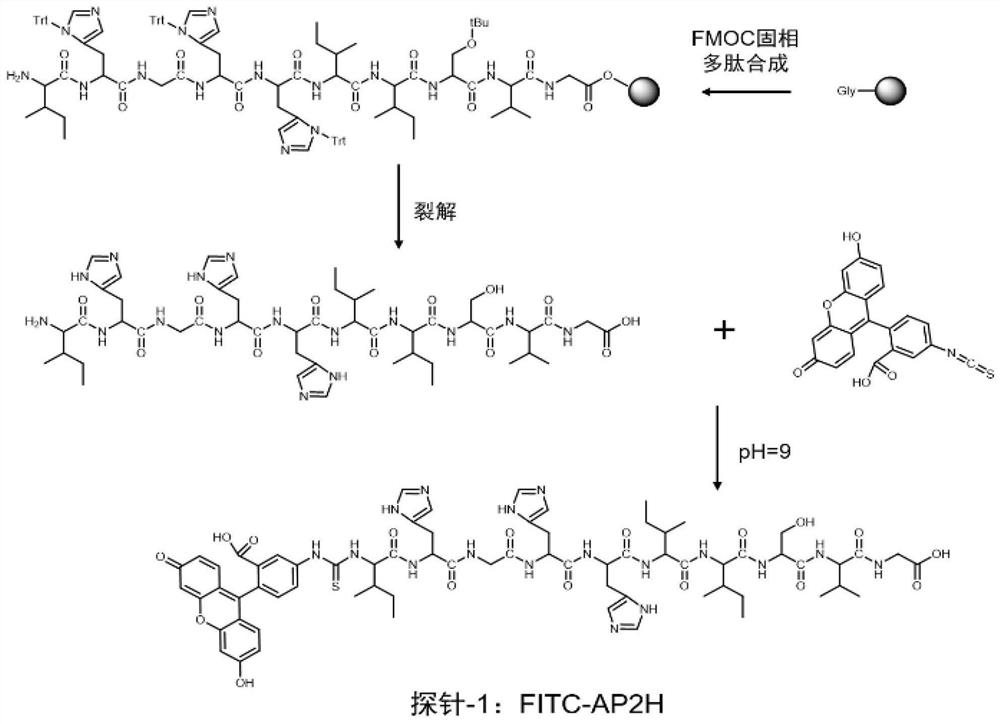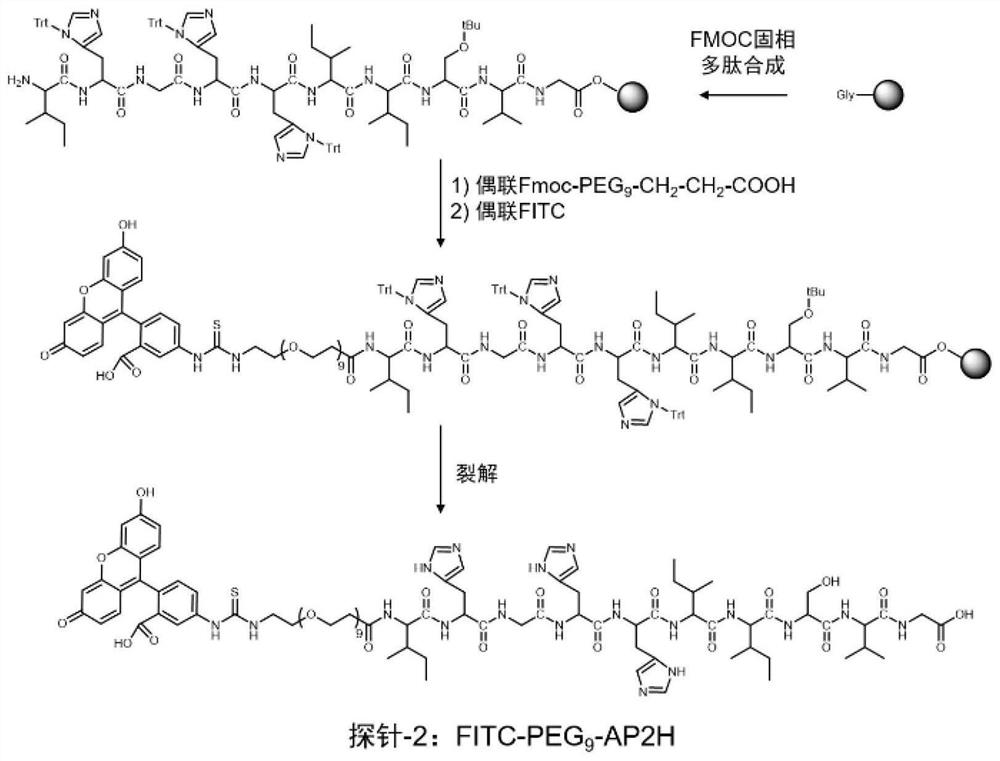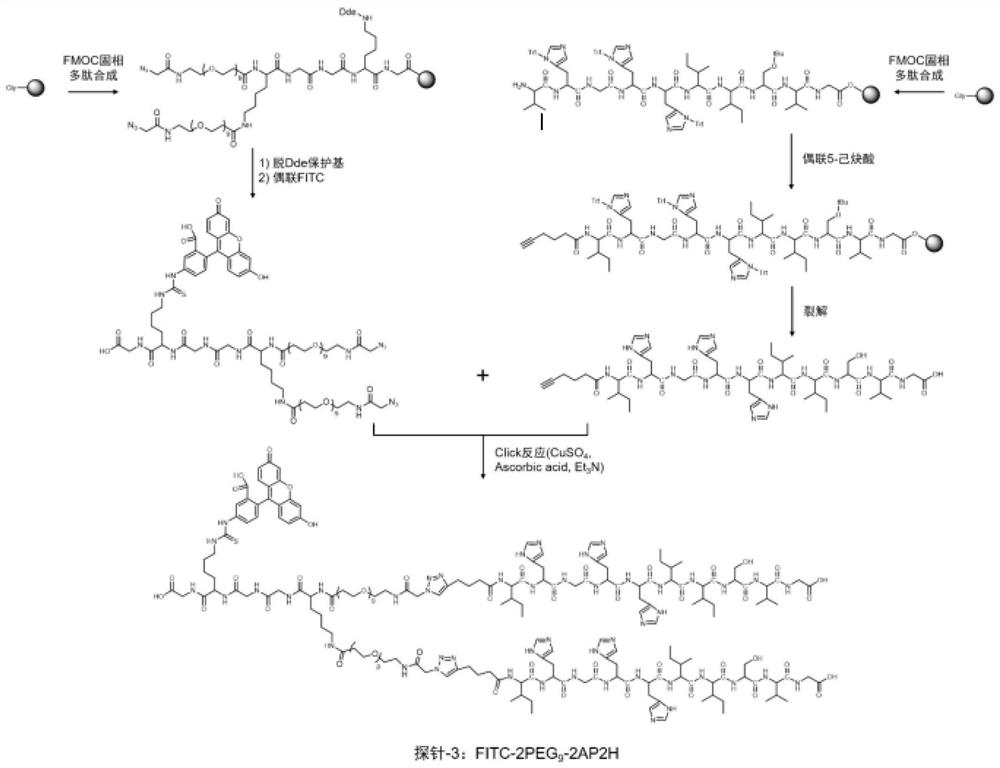A kind of bivalent targeting polypeptide probe and preparation method thereof
A technology for targeting polypeptides and probes, which is applied in the field of bivalent targeting polypeptide probes and its preparation, and can solve problems such as weak affinity between polypeptides and target molecules
- Summary
- Abstract
- Description
- Claims
- Application Information
AI Technical Summary
Problems solved by technology
Method used
Image
Examples
Embodiment 1
[0065] Embodiment 1, FITC-2PEG 9 -Synthesis of 2AP2H (probe-3)
[0066] The synthesis of the peptide probe is mainly divided into three steps, that is, the synthesis of the backbone core peptide, the synthesis of the branch targeting peptide and the Click reaction under the liquid phase condition.
[0067] The synthesis process is as image 3 shown.
[0068] 1. Synthesis of backbone core peptide
[0069] The peptide KGGKG was synthesized from the C-terminus on the Fmoc-Gly-Wang resin by FMOC solid-phase peptide synthesis, and the amino acids were coupled to the resin one by one, and then Fmoc- PEG 9 -CH 2 -CH 2 -COOH molecule, and then link azidoacetic acid, and couple FITC on the epsilon amino group of C-terminal lysine. The peptide chain is then cleaved from the resin under strong acid, simultaneously removing the remaining side chain protecting groups. The specific experimental steps are as follows:
[0070] Take 100 mg of Fmoc-Gly-Wang resin, swell with DMF for 20...
Embodiment 2
[0078] Example 2. Characterization of the affinity of polypeptide ligands and tumor cells by flow cytometry
[0079] experimental method:
[0080] Prepare EDTA cell digest solution. Weigh 3.639g of EDTA-2Na salt solid, add it to 19.55mL of PBS solution (pH7.4), add an appropriate amount of NaOH to adjust the pH of the buffer solution until EDTA-2Na is completely dissolved, and the pH is about 8.0 at this time, so the EDTA mother solution (concentration is 0.5mol / L). When digesting the cells in the experiment, dilute the EDTA stock solution to 5mmol / L with PBS.
[0081] Digest HepG2 cells with 5 mmol / L EDTA solution for 10 min, pipette the cells to suspend the adherent cells evenly in the digestion solution, centrifuge the cell suspension for 5 min with a centrifuge at 1000 r / min (centrifugal force 180 g), discard the supernatant, Cells were resuspended in PBS and washed 2 times. Finally, the cells were suspended in Hanks dextrose buffer solution (HBSS) containing calcium a...
PUM
 Login to View More
Login to View More Abstract
Description
Claims
Application Information
 Login to View More
Login to View More - R&D
- Intellectual Property
- Life Sciences
- Materials
- Tech Scout
- Unparalleled Data Quality
- Higher Quality Content
- 60% Fewer Hallucinations
Browse by: Latest US Patents, China's latest patents, Technical Efficacy Thesaurus, Application Domain, Technology Topic, Popular Technical Reports.
© 2025 PatSnap. All rights reserved.Legal|Privacy policy|Modern Slavery Act Transparency Statement|Sitemap|About US| Contact US: help@patsnap.com



